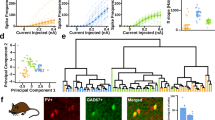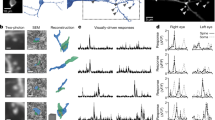Abstract
Inhibitory interneurons are critical to sensory transformations, plasticity and synchronous activity in the neocortex1,2. There are many types of inhibitory neurons, but their synaptic organization is poorly understood. Here we describe two functionally distinct inhibitory networks comprising either fast-spiking (FS) or low-threshold spiking (LTS) neurons. Paired-cell recordings showed that inhibitory neurons of the same type were strongly interconnected by electrical synapses, but electrical synapses between different inhibitory cell types were rare. The electrical synapses were strong enough to synchronize spikes in coupled interneurons. Inhibitory chemical synapses were also common between FS cells, and between FS and LTS cells, but LTS cells rarely inhibited one another. Thalamocortical synapses, which convey sensory information to the cortex, specifically and strongly excited only the FS cell network. The electrical and chemical synaptic connections of different types of inhibitory neurons are specific, and may allow each inhibitory network to function independently.
This is a preview of subscription content, access via your institution
Access options
Subscribe to this journal
Receive 51 print issues and online access
$199.00 per year
only $3.90 per issue
Buy this article
- Purchase on Springer Link
- Instant access to full article PDF
Prices may be subject to local taxes which are calculated during checkout




Similar content being viewed by others
References
Somogyi,P., Tamas,G., Lujan,R. & Buhl,E. H. Salient features of synaptic organisation in the cerebral cortex. Brain. Res. Rev. 26, 113–135 (1998).
Jones,E. G. GABAergic neurons and their role in cortical plasticity in primates. Cerebral Cortex 3, 361–372 (1993).
Agmon,A. & Connors,B. W. Thalamocortical responses of mouse somatosensory (barrel) cortex in vitro. Neuroscience 41, 365–379 (1991).
Simons,D. J. & Woolsey,T. A. Morphology of Golgi-Cox-impregnated barrel neurons in rat SmI cortex. J. Comp. Neurol. 230, 119–132 (1984).
Thomson,A. M. & Deuchars,J. Synaptic interactions in neocortical local circuits: dual intracellular recordings in vitro. Cereb. Cortex 7, 510–522 (1997).
Kawaguchi,Y. & Kubota,Y. GABAergic cell subtypes and their synaptic connections in rat frontal cortex. Cereb. Cortex 7, 476–486 (1997).
Reyes,A. & Sakmann,B. Target-cell-specific facilitation and depression in neocortical circuits. Nature Neurosci. 1, 279–285 (1998).
Connors,B. W. & Gutnick,M. J. Intrinsic firing patterns of diverse neocortical neurons. Trends Neurosci. 13, 99–104 (1990).
Agmon,A. & Connors,B. W. Correlation between intrinsic firing patterns and thalamocortical synaptic responses of neurons in mouse barrel cortex. J. Neurosci. 12, 319–329 (1992).
Swadlow,H. A., Beloozerova,I. N. & Sirota,M. G. Sharp, local synchrony among putative feed-forward inhibitory interneurons of rabbit somatosensory cortex. J. Neurophysiol. 79, 567–582 (1998).
Staiger,J. F., Zilles,K. & Freund,T. F. Distribution of GABAergic elements postsynaptic to ventroposteromedial thalamic projections in layer IV of rat barrel cortex. Eur. J. Neurosci. 8, 2273–2285 (1996).
Gil,Z., Connors,B. W. & Amitai,Y. Efficacy of thalamocortical and intracortical synaptic connections: quanta, innervation, and reliability. Neuron 23, 385–397 (1999).
Connors,B. W., Benardo,L. S. & Prince,D. A. Coupling between neurons of the developing rat neocortex. J. Neurosci. 3, 773–782 (1983).
Peinado,A., Yuste,R. & Katz,L. C. Extensive dye coupling between rat neocortical neurons during the period of circuit formation. Neuron 10, 103–114 (1993).
Benardo,L. S. Recruitment of GABAergic inhibition and synchronization of inhibitory interneurons in rat neocortex. J. Neurophysiol. 77, 3134–3144 (1997).
Sloper,J. J. & Powell,T. P. Gap junctions between dendrites and somata of neurons in the prime sensori-motor cortex. Proc. R. Soc. Lond. B 203, 39–47 (1978).
Bozhilova-Pastirova,A. & Ovtscharoff,W. Structure of the synaptic junctions in the rat sensorimotor cortex: freeze-etching study of neuronal gap junctions. Neurosci. Lett. 201, 265–267 (1995).
Bennett,M. V. L. in Handbook of Physiology, Section 1: The Nervous System, Part I (eds Brookhart, J. M. & Mountcastle, V. B.) 357–416 (American Physiological Society, Bethesda, 1977).
Dermietzel,R. & Spray,D. C. Gap junctions in the brain: where, what type, how many and why? Trends Neurosci. 16, 186–192 (1993).
Jefferys,J. G. R. Nonsynaptic modulation of neuronal activity in the brain: electric currents and extracellular ions. Physiol. Rev. 75, 689–723 (1995).
Johnston,M. F., Simon,S. A. & Ramon,F. Interaction of anesthetics with electrical synapses. Nature 286, 498–500 (1980).
Veenstra,R. D. Size and selectivity of gap junction channels formed from different connexins. J. Bioenerg. Biomembr. 28, 327–337 (1996).
Nadarajah,B., Jones,A. M., Evans,W. H. & Parnevelas,J. G. Differential expression of connexins during neocortical development and neuronal circuit formation. J. Neurosci. 17, 3096–3111 (1997).
Christie,M. J., Williams,J. T. & North,R. A. Electrical coupling synchronizes subthreshold activity in locus coeruleus neurons in vitro from neonatal rats. J. Neurosci. 9, 3584–3589 (1989).
Mann-Metzer,P. & Yarom,Y. Electrotonic coupling interacts with intrinsic properties to generate synchronized activity in cerebellar networks of inhibitory interneurons. J. Neurosci. 19, 3298–3306 (1999).
Michelson,H. B. & Wong,R. K. Synchronization of inhibitory neurones in the guinea-pig hippocampus in vitro. J. Physiol. (Lond.) 477, 35–45 (1994).
Jefferys,J. G., Traub,R. D. & Whittington,M. A. Neuronal networks for induced ‘40 Hz’ rhythms. Trends Neurosci. 19, 202–208 (1996).
Buhl,E. H., Tamas,G. & Fisahn,A. Cholinergic activation and tonic excitation induce persistent gamma oscillations in mouse somatosensory cortex in vitro. J. Physiol. (Lond.) 513, 117–126 (1998).
Kawaguchi,Y. & Shindou,T. J. Noradrenergic excitation and inhibition of GABAergic cell types in rat frontal cortex. J. Neurosci. 18, 6963–6976 (1998).
Xiang,Z., Huguenard,J. R. & Prince,D. A. Cholinergic switching within neocortical inhibitory networks. Science 281, 985–988 (1999).
Acknowledgements
We thank S. Patrick for technical assistance, Y. Amitai and M. Bear for comments on the manuscript, and R. Benoit for gifts of anti-somatostatin antibodies. This work was supported by a fellowship to J.R.G. from NIH and a grant to B.W.C. from NIH.
Author information
Authors and Affiliations
Corresponding author
Rights and permissions
About this article
Cite this article
Gibson, J., Beierlein, M. & Connors, B. Two networks of electrically coupled inhibitory neurons in neocortex. Nature 402, 75–79 (1999). https://doi.org/10.1038/47035
Received:
Accepted:
Issue Date:
DOI: https://doi.org/10.1038/47035
This article is cited by
-
On the physiological and structural contributors to the overall balance of excitation and inhibition in local cortical networks
Journal of Computational Neuroscience (2024)
-
Positive and biphasic extracellular waveforms correspond to return currents and axonal spikes
Communications Biology (2023)
-
Developmental loss of ErbB4 in PV interneurons disrupts state-dependent cortical circuit dynamics
Molecular Psychiatry (2023)
-
Spatial Distribution of Parvalbumin-Positive Fibers in the Mouse Brain and Their Alterations in Mouse Models of Temporal Lobe Epilepsy and Parkinson’s Disease
Neuroscience Bulletin (2023)
-
Distribution Patterns of Subgroups of Inhibitory Neurons Divided by Calbindin 1
Molecular Neurobiology (2023)
Comments
By submitting a comment you agree to abide by our Terms and Community Guidelines. If you find something abusive or that does not comply with our terms or guidelines please flag it as inappropriate.



